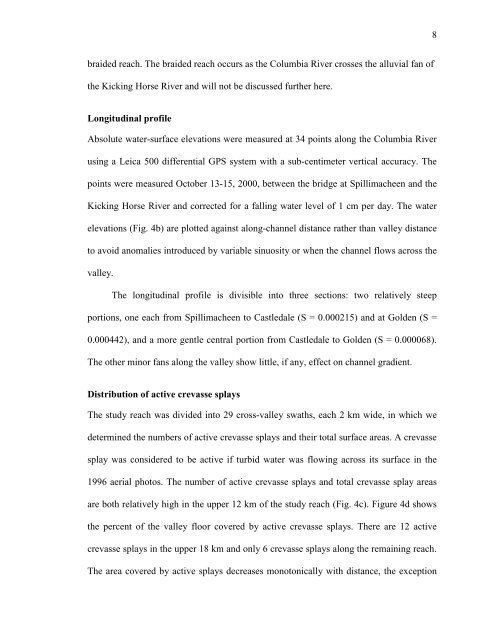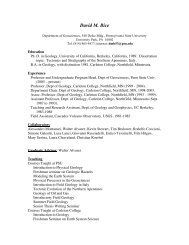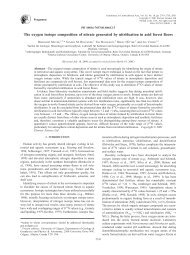Origin of Anastomosis in the Upper Columbia River - Department of ...
Origin of Anastomosis in the Upper Columbia River - Department of ...
Origin of Anastomosis in the Upper Columbia River - Department of ...
Create successful ePaper yourself
Turn your PDF publications into a flip-book with our unique Google optimized e-Paper software.
8<br />
braided reach. The braided reach occurs as <strong>the</strong> <strong>Columbia</strong> <strong>River</strong> crosses <strong>the</strong> alluvial fan <strong>of</strong><br />
<strong>the</strong> Kick<strong>in</strong>g Horse <strong>River</strong> and will not be discussed fur<strong>the</strong>r here.<br />
Longitud<strong>in</strong>al pr<strong>of</strong>ile<br />
Absolute water-surface elevations were measured at 34 po<strong>in</strong>ts along <strong>the</strong> <strong>Columbia</strong> <strong>River</strong><br />
us<strong>in</strong>g a Leica 500 differential GPS system with a sub-centimeter vertical accuracy. The<br />
po<strong>in</strong>ts were measured October 13-15, 2000, between <strong>the</strong> bridge at Spillimacheen and <strong>the</strong><br />
Kick<strong>in</strong>g Horse <strong>River</strong> and corrected for a fall<strong>in</strong>g water level <strong>of</strong> 1 cm per day. The water<br />
elevations (Fig. 4b) are plotted aga<strong>in</strong>st along-channel distance ra<strong>the</strong>r than valley distance<br />
to avoid anomalies <strong>in</strong>troduced by variable s<strong>in</strong>uosity or when <strong>the</strong> channel flows across <strong>the</strong><br />
valley.<br />
The longitud<strong>in</strong>al pr<strong>of</strong>ile is divisible <strong>in</strong>to three sections: two relatively steep<br />
portions, one each from Spillimacheen to Castledale (S = 0.000215) and at Golden (S =<br />
0.000442), and a more gentle central portion from Castledale to Golden (S = 0.000068).<br />
The o<strong>the</strong>r m<strong>in</strong>or fans along <strong>the</strong> valley show little, if any, effect on channel gradient.<br />
Distribution <strong>of</strong> active crevasse splays<br />
The study reach was divided <strong>in</strong>to 29 cross-valley swaths, each 2 km wide, <strong>in</strong> which we<br />
determ<strong>in</strong>ed <strong>the</strong> numbers <strong>of</strong> active crevasse splays and <strong>the</strong>ir total surface areas. A crevasse<br />
splay was considered to be active if turbid water was flow<strong>in</strong>g across its surface <strong>in</strong> <strong>the</strong><br />
1996 aerial photos. The number <strong>of</strong> active crevasse splays and total crevasse splay areas<br />
are both relatively high <strong>in</strong> <strong>the</strong> upper 12 km <strong>of</strong> <strong>the</strong> study reach (Fig. 4c). Figure 4d shows<br />
<strong>the</strong> percent <strong>of</strong> <strong>the</strong> valley floor covered by active crevasse splays. There are 12 active<br />
crevasse splays <strong>in</strong> <strong>the</strong> upper 18 km and only 6 crevasse splays along <strong>the</strong> rema<strong>in</strong><strong>in</strong>g reach.<br />
The area covered by active splays decreases monotonically with distance, <strong>the</strong> exception




